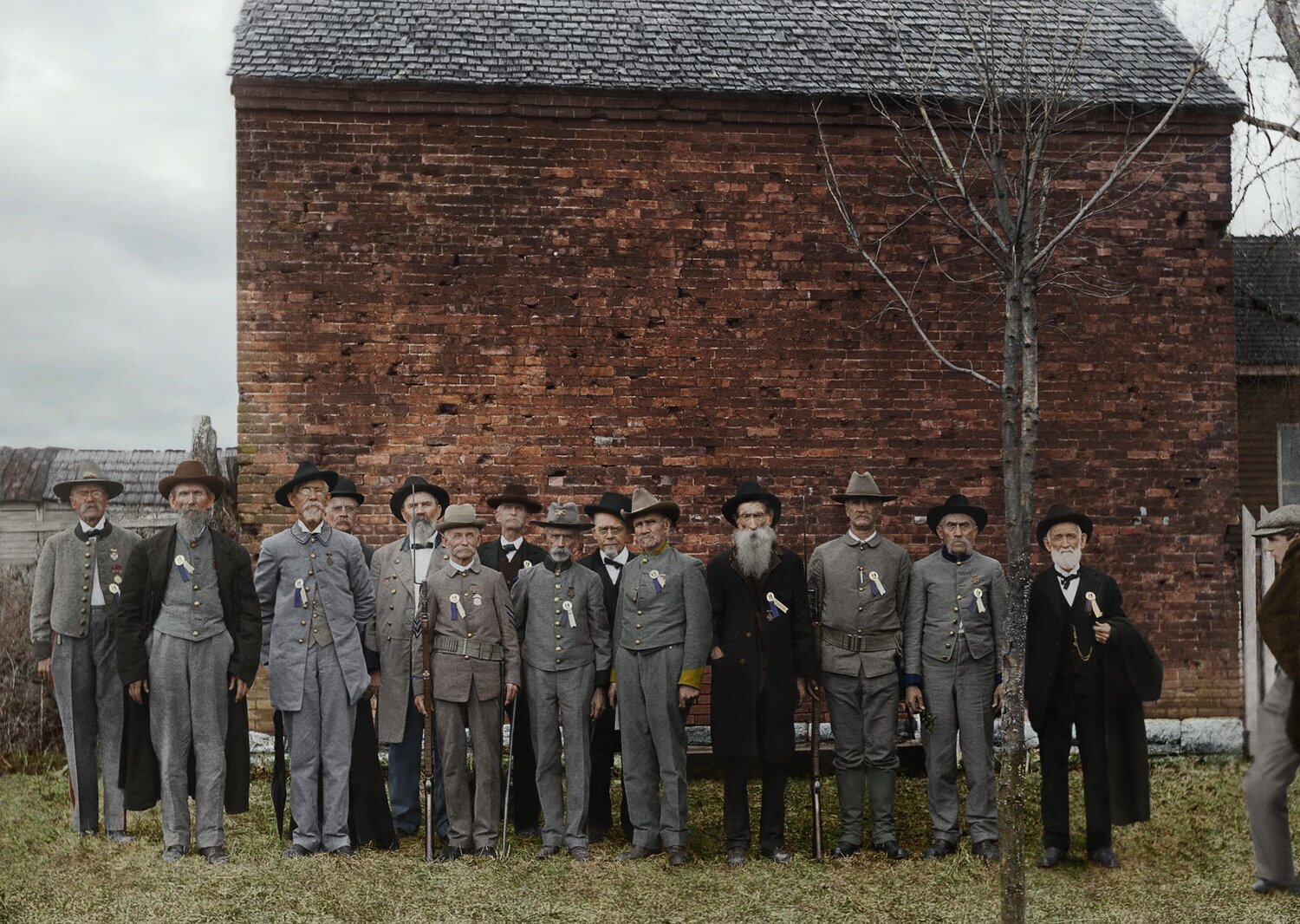How did Civil War soldiers cope after the fighting ended?
Descriptions by Joanna Stephens, BOFT’s curator:
The 50th anniversary of the Battle of Franklin was held in 1914 as a Blue and Gray Reunion; US and Confederate soldiers walked the ground together and remembered the events of the Battle of Franklin. The photo, taken in front of the Carter House smokehouse, showed the true feelings of those in attendance: “Whether blue or gray it makes no difference to us. We are friends and brothers now.”
This photograph was originally black and white. The Battle of Franklin Trust recently had it colorized. Colorizing artists use computer programs and the colors from known objects in the photographs to turn the black and white shades into color!
As the daughter of a military veteran, I have always had a different feeling and experience when talking about Civil War veterans when I am at work. I know the challenges my father (and my family) faced when he first retired and made the transition back into the civilian world, and I know it is difficult to try and understand the personal struggles of the men returning home after the American Civil War.
William Weatherman served in the 57th Indiana Regiment. He fought and was wounded at the Battle of Franklin. After the war, William Weatherman became a minister. The photograph, which was taken circa 1895.
Southerners were forced to reconcile their life and sacrifice with an effort for independence that failed. Northerners were forced to weigh the sacrifice they made in their successful effort to preserve the Union. Soldiers from both sides were confronted with the home-front realities all soldiers returning from war face: loving families and communities, but few who could relate to what they experienced. Returning to their previous lives, whether on the farm or in the city, was the only option for most of the men. As with many veterans today, special groups were formed. This allowed the Civil War Veterans to talk to other men who had shared similar experiences and gone through a time that was truly inexplicable to those around them.
G.A.R. Membership Lapel Pin of William Weatherman. About 1 inch tall.
Two main veterans’ organizations were established in the U.S. after the war: The United Confederate Veterans (U.C.V.) and the Grand Army of the Republic (G.A.R.). These two organizations had national publications, held reunions, and worked to get veterans compensation for their service and, in some cases, their injuries. At its height, the G.A.R. had over 490,000 members; the U.C.V. had a membership of over 160,000.
When we talk about the American Civil War, we often focus on the terrible loss of life. And while that was a horrific part of the story, many people don’t consider what it was like for the survivors after the battles and after the war was over. These veterans’ groups helped thousands of men cope with what they had experienced.
Questions:
Examine the items. What day did the Battle of Franklin occur?
Read the first page of the Confederate Veteran. Poems like this one were common occurrences in the publication. What does this poem tell you about the sentiment of Confederate veterans and people of the South?
What does “Dixie” refer to?
Examine the List of Survivors. Is this a list of Confederate veterans or US veterans? Are there any names that stick out?
Look at the advertisements on the Grand Army Sentinel. Do you recognize any of the businesses?
Compare and contrast the Confederate Veteran and Grand Army Sentinel. What are the similarities and what are the differences?
What can we learn from William Weatherman’s photograph and pin?
Answers:
The Battle of Franklin occurred on November 30, 1864. The date is at the top of the Blue and Gray Survivors’ Register. The 1914 Reunion took place on the 50th anniversary of the Battle of Franklin.
From the poem, we can tell that honoring the Confederate soldiers was very important. The lines, “And if I were a generous foe, / I’d honor him whose heart’s best throe / Leaped to that music soft and low, / Our Dixie,” mean that not only do Southerners want the South to remember the dead, but they also want the entire country to remember too.
Dixie is slang for the South. It is unclear how the word originated, but by the time of the Civil War it was a common term used by people in the South and North.
This is a list of both Confederate and US veterans. If you look closely, you’ll see men who fought from Tennessee, Michigan, Mississippi, Indiana, Ohio, and Alabama regiments. Two names that you might find intriguing are in the second column – RJ Neal (who was shot three times at Franklin) and Dr. J.H. McNeilly (Chaplain).
The large advertisement on the bottom of the cover is for the Maxwell House. The Maxwell House was a hotel in downtown Nashville. The coffee brand, Maxwell House, has its origins at the hotel.
Here are a few of the similarities and differences. You may notice more! Similarities: Both are published in Nashville, Tennessee. Both are Vol. II. They both say they are publications for soldiers in the Southern States. Differences: The Confederate Veteran is a quarterly magazine (published four times a year) and the Grand Army Sentinel is semi-monthly (comes out every other month). The Confederate Veteran has a poem on the cover and the Grand Army Sentinel has advertisements.
There is a lot we can learn from William Weatherman’s items. Even though he was wounded at the Battle of Franklin, he did not need an amputation. He still has all his limbs in the photograph. He, of course, was a member of the G.A.R.
Vocab Words:
Reconcile – Restoring friendliness between two groups.
Home-front – The population and activities of the civilian (non-military) population still at home.
Circa – Approximately.
Sentiment – The view or attitude toward a people or event. Often, they are feelings of nostalgia.






